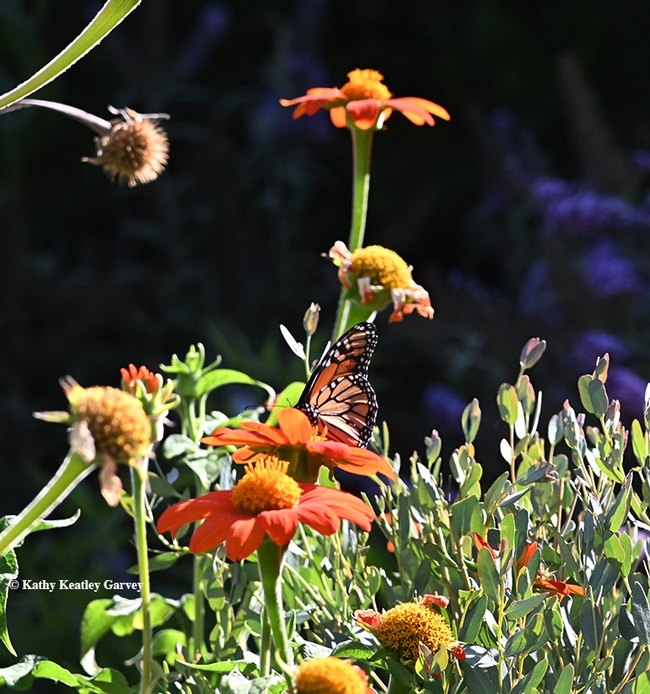We never thought we'd see one this year.
And then it arrived.
The first monarch sighting of the year.
A Danaus plexippus majestically touched down on our Mexican sunflowers (Tithonia) around 5 this afternoon in our pollinator garden in Vacaville, circled the milkweed plants about 10 times, and then fluttered over the roof and vanished.
Meanwhile, we managed to grab a couple of photos of the iconic butterfly.
Fellow monarch enthusiasts report the scarcity of monarchs.
"Haven't see any this year," said one.
"Me, either," said another.
"No, not a single one," said yet another. "I'm looking."
Rita LeRoy has seen two at the Loma Vista Farm, Vallejo.
"Send some over to us," we said.
We remember butterfly guru Art Shapiro, UC Davis distinguished professor of evolution and ecology, commenting at a meeting hosted at UC Davis Feb. 28, 2019 by the Environmental Defense Fund, that "monarchs are on life support." The attendees--some scientists, some citizen scientists--were there to discuss "Recovering the Western Monarch Butterfly Population: Identifying Opportunities for Scaling Monarch Habitat in California's Central Valley."
The organizers related that "The latest population surveys indicate that monarchs overwintering on the central coast have declined 86% since last winter and now total 0.5% of their historical average. Population declines have spurred greater scientific study, funding, and coordination around the western monarch. California legislators appropriated $3 million in funding to the CA Wildlife Conservation Board to establish the Monarch Butterfly and Pollinator Rescue Program."
"Additionally," they said, "the Western Association of Fish and Wildlife Agencies released a Western Monarch Butterfly Conservation Plan calling for an additional 50,000 acres of monarch-friendly habitat in the California Central Valley and adjacent foothills by 2029. Join Environmental Defense Fund along with farmers, restoration practitioners, and scientists for an invitation-only workshop to share expert knowledge and identify strategic opportunities for restoring monarch butterfly habitat across the Central Valley. We will discuss important topics including opportunities for monarch habitat in the food production landscape, incentivizing monarch habitat restoration using limited resources, production and distribution of native plants, and other subjects that will put the western monarch butterfly population on the path to recovery. We will use the results of the workshop to inform conservation initiatives and effectively and efficiently allocate funds and resources for optimal conservation outcomes."
Shapiro was one of the five speakers in the "State of the Science" workshop section. He has been monitoring Central Valley's butterfly population since 1972 and maintains a website on his research.
In his presentation, Shapiro declared that "monarchs are on life support in California, and we are reduced to prescribing placebos."
"Consider a doctor faced with a patient in rapid decline," Shapiro told the group. "All tests have failed to identify the cause. What is the doctor to do? You can't prescribe treatment for an undiagnosed illness, can you? You can make a wild stab at a prescription on the basis that the patient is going to die anyway, and MAYBE, just maybe, this drug will do some good. Or you can prescribe a placebo, just to reassure the patient that you are doing something. That's where things get interesting. Occasionally a patient improves drastically on a placebo. Maybe he would have improved anyway; there's no way of knowing. Suppose our patient has a complete remission despite having received only a placebo. Does our doctor convince himself the placebo cured him? As of right now, the Monarch is on life support in California, and we are reduced to prescribing placebos. If our patient comes back from the brink—as history suggests it may well—will we convince ourselves that our placebos worked? Probably. And that's not how to do science. That's what philosophers call the fallacy of post hoc, ergo propter hoc. We can do can do better than that!" (Read his presentation on a Bug Squad blog.)
Meanwhile, we know there's at least one monarch in Vacaville...Maybe it's a female and will return to lay eggs on our milkweed. We can only hope.
Attached Images:
